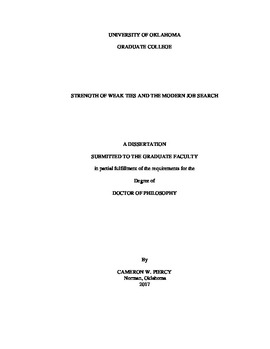| dc.description.abstract | This dissertation examines the social networks of job seekers and information sources using two samples of Americans who have sought jobs in the past two-years. After a brief introductory chapter and a chapter reviewing network terminology and three network theories (strength of weak ties, structural holes theory, and social capital), two studies were conducted. The final chapter proposes nested levels of network influence and suggests revision to social network theory and research.
Study 1 explored a random-digit dial survey of job seekers collected by the Pew Research Center. Data from participants who sought a job in the past two years was used to construct an affiliation (two-mode) network of job seekers and types of sources. Results from correspondence analysis, centrality measures, and an exponential random graph model (ERGM) show that job seekers used sources in conjunction at a rate greater than chance. Specifically, job seekers used three types of sources: (a) social sources (close friends and family, personal acquaintances, and professional acquaintances); (b) formal sources (print advertisements, career events, and employment agencies); (c) and online sources (social networking sites and online information and resources). Based on centrality measures, online information and resources were at the center of job seeker’s affiliation network. A discussion section reviews implications for Strength of Weak Ties theory as well as practical implications for the job search.
Study 2 uses a survey of Amazon Mechanical Turk ® (MTurk) workers from the United States who have sought a job in the past two years. These participants responded to questions about the sources they used during the job search, including information sources accessed online and offline. Strong ties included close friends and family contacted online and in-person as well as websites; in contrast, the weakest ties were direct online application, employment agencies, and career events. Results showed that, controlling for homophily, tie strength was positively related to social support, bridging, and ease of access. Additionally, weakness of tie was related to influence. Contrary to strength of weak ties theory, information quality was not related to tie strength. Finally, this study explored within-person attributes related to tie strength. Perceptions of the job search as a networking task were positively related to use of stronger ties; in contrast, feelings of uncertainty, above one’s comfort, led to use of weaker ties on average. Perceptions of a larger personal network had a positive indirect effect on the strength of ties.
A final chapter presents implications for sociomateriality, latent tie theory, and network research, in general. These studies paint a complicated picture both supporting and challenging strength of weak ties theory. Specifically, the final chapter discusses these findings and concludes that the modern job search does not follow the premises accepted by most strength of weak ties research. Implications of research findings in three major areas: (a) the social and material similarities and differences between human and non-human information sources are discussed, (b) the situated use of ties is explored using the lens of latent tie theory, (c) the implications for social network analysis are detailed at multiple levels. | en_US |
